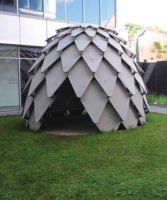Up Periscope and Down Building in Chicago

Up Periscope and Down Building in Chicago
Photo © Mark Ballogg

Up Periscope and Down Building in Chicago

Up Periscope and Down Building in Chicago

Up Periscope and Down Building in Chicago
Once lowered into place, contractors installed a steel structure and deck to cover the hall (above), which is 30 feet below Lake Michigan’s water level.
Photo: Courtesy Goettsch Partners

Up Periscope and Down Building in Chicago
The boxed beams taper from 24 inches at the center to 54 inches at the sides. The canted, cast-in-place concrete walls suggest the space is larger than its 27,000 square feet.
Photo: © Mark Ballogg

Up Periscope and Down Building in Chicago
The boxed beams taper from 24 inches at the center to 54 inches at the sides. The canted, cast-in-place concrete walls suggest the space is larger than its 27,000 square feet.

Up Periscope and Down Building in Chicago
The boxed beams taper from 24 inches at the center to 54 inches at the sides. The canted, cast-in-place concrete walls suggest the space is larger than its 27,000 square feet.
Photo: © Ion Miller

Up Periscope and Down Building in Chicago
The boxed beams taper from 24 inches at the center to 54 inches at the sides. The canted, cast-in-place concrete walls suggest the space is larger than its 27,000 square feet.
Photo: © Ion Miller





Post a comment to this article
Report Abusive Comment